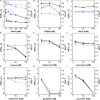Genomic and Transcriptomic Investigation of the Physiological Response of the Methylotroph Bacillus methanolicus to 5-Aminovalerate
- PMID: 33995329
- PMCID: PMC8119775
- DOI: 10.3389/fmicb.2021.664598
Genomic and Transcriptomic Investigation of the Physiological Response of the Methylotroph Bacillus methanolicus to 5-Aminovalerate
Abstract
The methylotrophic thermophile Bacillus methanolicus can utilize the non-food substrate methanol as its sole carbon and energy source. Metabolism of L-lysine, in particular its biosynthesis, has been studied to some detail, and methanol-based L-lysine production has been achieved. However, little is known about L-lysine degradation, which may proceed via 5-aminovalerate (5AVA), a non-proteinogenic ω-amino acid with applications in bioplastics. The physiological role of 5AVA and related compounds in the native methylotroph was unknown. Here, we showed that B. methanolicus exhibits low tolerance to 5AVA, but not to related short-chain (C4-C6) amino acids, diamines, and dicarboxylic acids. In order to gain insight into the physiological response of B. methanolicus to 5AVA, transcriptomic analyses by differential RNA-Seq in the presence and absence of 5AVA were performed. Besides genes of the general stress response, RNA levels of genes of histidine biosynthesis, and iron acquisition were increased in the presence of 5AVA, while an Rrf2 family transcriptional regulator gene showed reduced RNA levels. In order to test if mutations can overcome growth inhibition by 5AVA, adaptive laboratory evolution (ALE) was performed and two mutants-AVA6 and AVA10-with higher tolerance to 5AVA were selected. Genome sequencing revealed mutations in genes related to iron homeostasis, including the gene for an iron siderophore-binding protein. Overexpression of this mutant gene in the wild-type (WT) strain MGA3 improved 5AVA tolerance significantly at high Fe2+ supplementation. The combined ALE, omics, and genetics approach helped elucidate the physiological response of thermophilic B. methanolicus to 5AVA and will guide future strain development for 5AVA production from methanol.
Keywords: 5-aminovalerate; Bacillus methanolicus; adaptive laboratory evolution; bioplastics; differential RNA-Seq; methylotroph; physiology; whole-genome sequencing.
Copyright © 2021 Haupka, Brito, Busche, Wibberg and Wendisch.
Conflict of interest statement
The authors declare that the research was conducted in the absence of any commercial or financial relationships that could be construed as a potential conflict of interest.
Figures






Similar articles
-
Evaluation of Heterologous Biosynthetic Pathways for Methanol-Based 5-Aminovalerate Production by Thermophilic Bacillus methanolicus.Front Bioeng Biotechnol. 2021 Jun 28;9:686319. doi: 10.3389/fbioe.2021.686319. eCollection 2021. Front Bioeng Biotechnol. 2021. PMID: 34262896 Free PMC article.
-
Transcriptome analysis of thermophilic methylotrophic Bacillus methanolicus MGA3 using RNA-sequencing provides detailed insights into its previously uncharted transcriptional landscape.BMC Genomics. 2015 Feb 14;16(1):73. doi: 10.1186/s12864-015-1239-4. BMC Genomics. 2015. PMID: 25758049 Free PMC article.
-
Characterization of D-Arabitol as Newly Discovered Carbon Source of Bacillus methanolicus.Front Microbiol. 2019 Jul 31;10:1725. doi: 10.3389/fmicb.2019.01725. eCollection 2019. Front Microbiol. 2019. PMID: 31417519 Free PMC article.
-
Methylotrophy in the thermophilic Bacillus methanolicus, basic insights and application for commodity production from methanol.Appl Microbiol Biotechnol. 2015 Jan;99(2):535-51. doi: 10.1007/s00253-014-6224-3. Epub 2014 Nov 28. Appl Microbiol Biotechnol. 2015. PMID: 25431011 Review.
-
Bacillus methanolicus: an emerging chassis for low-carbon biomanufacturing.Trends Biotechnol. 2025 Feb;43(2):274-277. doi: 10.1016/j.tibtech.2024.06.013. Epub 2024 Jul 19. Trends Biotechnol. 2025. PMID: 39033040 Review.
Cited by
-
Efficient cell factories for the production of N-methylated amino acids and for methanol-based amino acid production.Microb Biotechnol. 2022 Aug;15(8):2145-2159. doi: 10.1111/1751-7915.14067. Epub 2022 Apr 30. Microb Biotechnol. 2022. PMID: 35488805 Free PMC article. Review.
-
Evaluation of Heterologous Biosynthetic Pathways for Methanol-Based 5-Aminovalerate Production by Thermophilic Bacillus methanolicus.Front Bioeng Biotechnol. 2021 Jun 28;9:686319. doi: 10.3389/fbioe.2021.686319. eCollection 2021. Front Bioeng Biotechnol. 2021. PMID: 34262896 Free PMC article.
References
-
- Barker H. A., D’Ari L., Kahn J. (1987). Enzymatic reactions in the degradation of 5-aminovalerate by Clostridium aminovalericum. J. Biol. Chem. 262 8994–9003. - PubMed
LinkOut - more resources
Full Text Sources
Other Literature Sources
Miscellaneous

